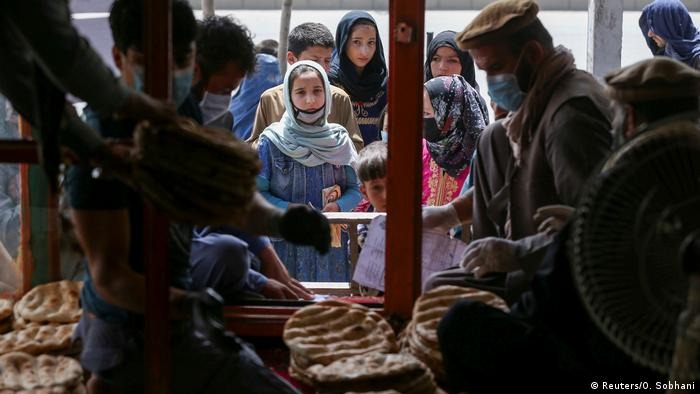After the Taliban took power in Afghanistan last year, $7 billion in Afghan assets were frozen in the US, as a sanction to curb the newly established regime.
Following the political catastrophe in August 2021, the economy has been deteriorating ever since. Suspension of international financial aid had caused a serious economic breakdown and the Afghan economy led its way to an apparent collapse.
This cessation of the funds is sending economic shocks through the country, as demands have diminished, inflation is on the rise and new macroeconomic challenges have begun to surface.
Afghanistan’s economic crisis – A look at how the severe problem is?
Public expenditures and aggregate demand have collapsed as a result of the unexpected end to international assistance, which was formerly equivalent to 45% of GDP and financing 75% of public expenditure.
The absence of grant inflows has also resulted in a shortage of hard currency causing a cash crisis. It is needed to finance imports (Afghanistan had a large trade imbalance that was equivalent to around 35% of GDP and was heavily dependent on imports for essential goods like food, fuel, and power).
International sanctions have severely disrupted international banking relationships, undermining Afghanistan’s central bank’s ability to smoothly implement the necessary macroeconomic adjustment. Afghanistan’s offshore Central bank assets were frozen due to the international sanctions imposed by various countries including the United States.
According to the World Bank, revenue generated and economic productivity in Afghanistan have decreased by 20–30%, imports have decreased by around 40%, and roughly 70% of Afghan households indicate they are unable to properly fulfil basic food or non-food needs.

The economy has receded by 20-30% since the Taliban’s takeover in August last year. The income has reduced significantly curtailing the domestic demand.
The crisis further intensified as international trade declined by 45% due to decreased regional demands, the disturbance to transnational expenditure methods and the Central bank’s loss of access to foreign assets.
Since August, Afghani has declined in value relative to the majority of the world’s major trading currencies, which reflects the reduction in aid inflows and increased unpredictability.
Between the end of July 2021 and mid-February 2022, Afghani declined by 14% versus the USD, 10% against the Euro, and 4% against the Pakistani Rupee.
A major fiscal contraction has been caused by the abrupt termination of international aid inflows and the challenging economic environment, with public spending likely to have plummeted by over 75%.
Only relatively modest humanitarian flows remain after all development and security aid, which once amounted to about US$8.5 billion annually, has been discontinued.
Afghanistan’s humanitarian crisis–Fuelled by the economic crisis
‘Afghanistan’s intensifying hunger and health crisis is urgent and at its root a banking crisis’
said John Sifton, Asia advocacy director at Human Rights Watch.
According to an assessment by the World Food Programme(WFP),‘ Almost 20 million people – half the population – are suffering either level-3 “crisis” or level-4 “emergency” levels of food insecurity. Over one million children under 5 – especially at risk of dying when deprived of food – are suffering from prolonged acute malnutrition, meaning that even if they survive, they face significant health problems, including stunting.’

Image Source-The New Humanitarian REUTERS/Ali Khara)
Apart from that, 90% of Afghans have suffered food insecurity since last year, and half the population or nearly 20 million people are facing acute hunger.
Afghanistan relied heavily on international aid to sustain and encompassed 75%of public expenditures.
A humanitarian crisis is being aroused by rapidly deteriorating economic conditions in an environment of extreme drought. Afghans are experiencing increased food insecurity, deepening poverty, and quickly growing unemployment. At the same time, a significant international humanitarian response is being mobilised and attempts are being made to rebuild crucial service delivery methods.
‘Afghan Fund’- An aid to stabilise Afghanistan’s collapsing economy
After the Taliban takeover of Afghanistan last year, President Joe Biden froze and seized money from Afghanistan’s central bank. An amount of nearly $7 billion in Afghan assets was frozen in the US, as a sanction to curb the newly established Taliban rule.
The Biden government has confirmed the establishment of a fund to inaugurate spending of $3.5 billion to benefit the people of Afghanistan.
The Afghan Fund aims to help stabilise Afghanistan’s economy and at the same time, respond to the cries of millions of Afghan suffering from a widespread humanitarian crisis.
The “Afghan Fund,” which has its headquarters in Switzerland, was established by the US on Wednesday in collaboration with its international allies, the Swiss government, and Afghan economic experts, will make it easier to use some Afghan central bank reserves for the benefit of the Afghan people without benefiting the Taliban.
As a result of the attacks on the US on September 11, 2001, the Taliban is being sued for the remaining $3.5 billion as the topic is under litigation.
As the humanitarian crisis worsens and Afghanistan struggles with a collapsing economy, can Afghan funds possibly turn around the scene for a promising future?











